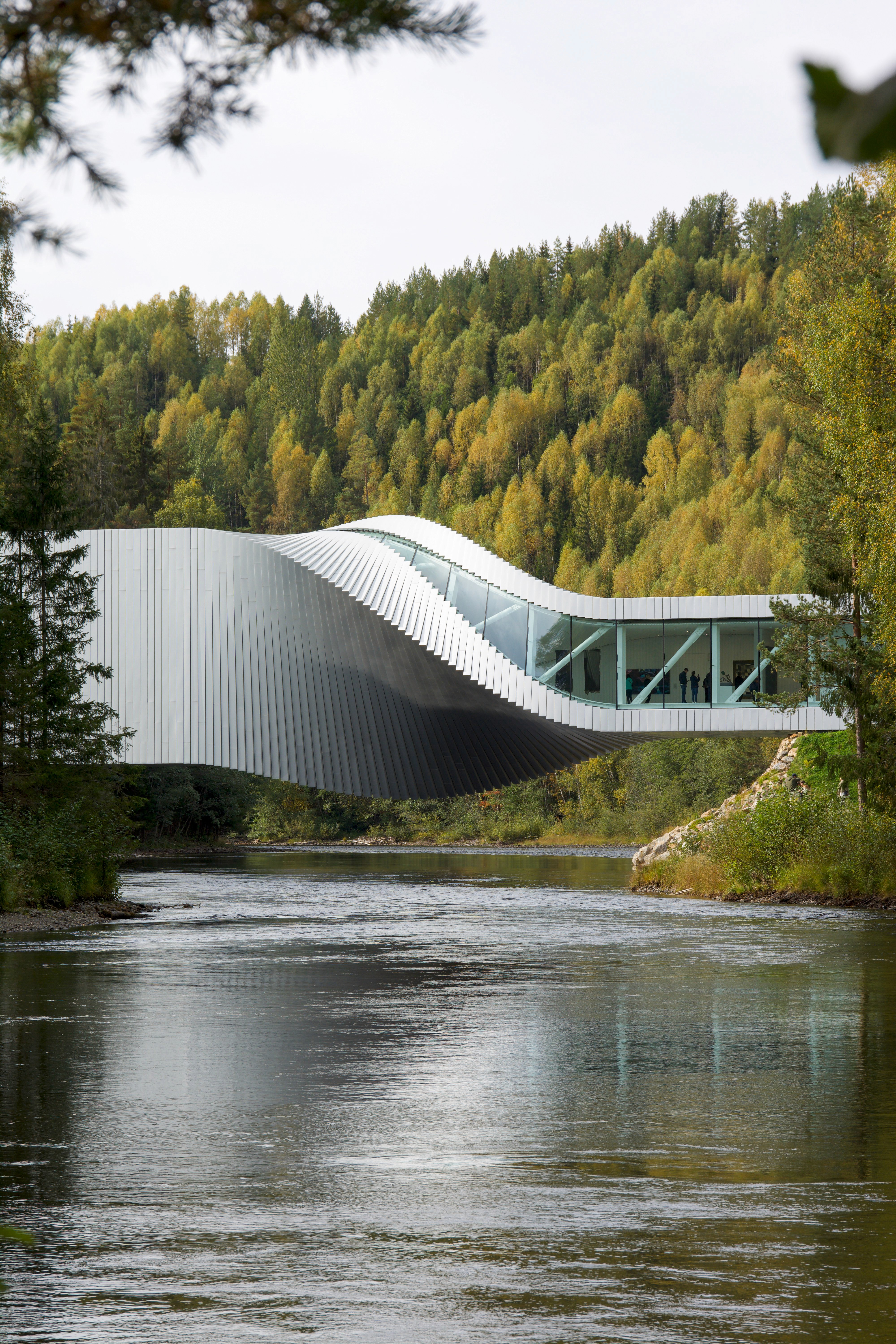Europe
A day trip to the Kistefos Sculpture Park, to visit "The Twist" in Norway

Ema Bakalova
Sep 21, 2020
Url copied!
Located an hour northwest of Olso in Jevnaker is the Kistefos Sculpture Park, home to one of the most elegant museums in the world. "The Twist" was built in the Kistefos Sculpture Park, which is home to art completed by renown artists such as Olafur Eliasson, Yayoi Kusama, Anish Kapoor, and many others. "The Twist" stands as a sculpture within the park, showcasing how architecture can serve as an art form, offering a unique museum-going experience for art enthusiasts and all other visitors.
"..it's a museum, it's a bridge, it's an inhabitable sculpture.." –Bjarke Ingels
Arriving at The Kistefos Sculpture Park
The journey to The Twist starts long before you actually arrive at the museum. Where with most museums it's common to park right outside the entrance, this museum is tucked away deep within the picturesque landscape of the Sculpture Park. You'll arrive at a parking lot, surrounded by trees and greenery. You'll hear the sounds of birds and the flow of the Randselva River in the distance.
You'll begin with a walk through the sculpture park. The park itself is a carefully curated outdoor space where you can encounter various sculptures and art installations integrated into the natural environment. The path meanders through the park, allowing you to explore the artwork at your own pace. I quite enjoyed the build up to the museum, and I found the engagement with the art and nature from different angles and perspectives to be quite exciting.
Connecting to nature
The transition from the sculpture park to the museum is a gradual one. You will navigate through steep topography and forested riverbanks. As you approach the museum, you will notice it reveals itself in the distance. This stirred a general feeling of anticipation and excitement, especially considering I hadn't encountered a building quite like it before.
Fun fact
A fun optical illusion about Kistefos Museum is that despite its twisting and spiraling appearance, the floors inside the building are predominantly flat. It is the facade of the building that appears to be twisting, not the entire building itself.
I went to visit the Twist during the fall time, so the leaves were in full bloom. The light colors of the foliage in the background juxtaposed the bold silver architectural lines of the museum. The museum is a bridge and a sculpture all in one, connecting the park on the two sides of the Randselva river. The building establishes a visual connection with the serene silver waters below, creating a simultaneous interplay of light and shadows across its surfaces. In contrast, the water's surface mirrors its surroundings, casting reflections onto the underside of the museum. Above, the twisting surface captures the light filtering through the forest, reminiscent of how the treetops in the backdrop catch and play with the sunlight.
The twist
Despite its visually deceiving appearance of a twisting, curved structure, the design of the Kistefos Museum is inherently rational. Approaching the building closer from the exterior, it becomes clear that the facade is an assembly of straight lines—devoid of curves. The facade is composed of a series of straight aluminum members strategically positioned in a repetitive manner to create the illusion of a twisting form. Inside, a similar language is used, and a series of straight wooden boards orchestrate this inverted twisting language enhancing the illusion of a twisting structure from within.
The prominent long window on the north side of the building was originally envisioned to twist upwards onto the roof, transforming into a skylight. However, the construction of this design proved to be exceedingly complex. As a result, the design was refined, culminating in the glass converging at a point as it reaches the roof of the building, seamlessly blending into the central twist of the structure.
Exhibitions and interior spaces
The north side of the museum was my favourite, featuring floor-to-ceiling windows that flooded the space with natural light and offered a panoramic view of the surrounding nature. This particular area was the most expansive space within the museum, providing lots of room to display the majority of the exhibited sculptures. Despite the museum's relatively small size, the thoughtful arrangement of the artwork as well as the open nature of the space itself, made it feel as though there was a lot of room to walk around.
When I visited, back in 2020, I saw the "Come out!" exhibition. It showcased a diverse range of artistic themes, delivering a compelling message about contemporary society and the future, aiming to inspire meaningful conversations. It delved into issues of individual and community rights, while shedding light on significant aspects of American history.
Much like other art galleries, the Kistefos Museum carefully curates its displays, featuring exceptional international artists whose work holds a unique and noteworthy quality. The museum also showcases talented Norwegian artists whose artwork complement the space as well. The sculptures within the park undergo regular rotation, adding to the ever-evolving experience, ensuring that each visit is always new and exciting.

Exhibitions
If you're interested, you can see a list of the past exhibitions at the Kistefos Museum here.
Through this blog, I hope to inspire you to seek out unique traveling opportunities, spark your love for travel and discover beautiful architecture. If you liked this article, sign up to get notified whenever a new post gets published!














